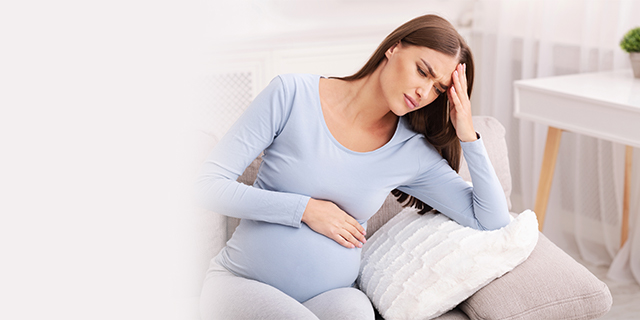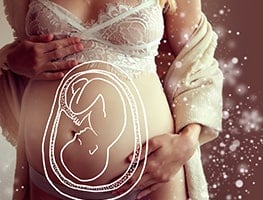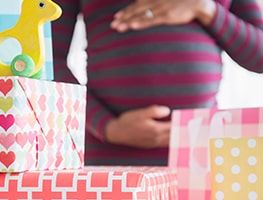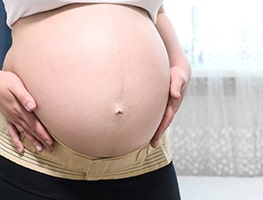Anaemia can develop at any time throughout your life, but it is more common during pregnancy.
This is why routine testing is done at regular intervals during a woman’s pregnancy, in particular within the first trimester and at around 20 weeks.
Anaemia is essentially a decrease in the number of red blood cells, known as haemoglobin, in the blood. The bone marrow is responsible for constantly producing and replenishing these highly specialised cells every 120 days. Because they are responsible for carrying oxygen to all the cells of the body, two of the first signs of iron deficiency anaemia are breathlessness and tiredness.
Many women have low iron levels early in their pregnancy because of blood loss through their monthly periods. In fact, iron deficiency is common among young women who may not even be aware they have it, especially those who experience very heavy periods. Though during pregnancy, when there is a span of amenorrhoea (no periods), iron stores have a chance to replenish.
How Anaemia Occurs
It is far easier to prevent anaemia from occurring in the first place than to treat it once it has been diagnosed. Even when dietary intake is sufficient, pregnant women can still become anaemic. This is why it is important to have every pregnancy monitored by a midwife, GP or obstetrician.
Anaemia occurs due to a variety of different reasons:
An incidental drop in a mother’s haemoglobin level, because of the demands of the growing baby
An overall increase in a mother’s circulating blood volume means the haemoglobin level becomes diluted from its normal level
A poor dietary intake of iron – very restrictive diets, elimination diets or low kilojoule intake can all lead to anaemia-related issues
Mothers who were underweight at the start of their pregnancy or who have experienced severe morning sickness are more at risk
Through blood loss, where there is a decrease in overall blood volume as well as haemoglobin levels – e.g. threatened miscarriage, ante-partum haemorrhage or other bleeding can all contribute
During a multiple pregnancy with twins/triplets/ quadruplets or more, the risks of becoming anaemic are higher
Women who have had a previous miscarriage or pregnancies in close succession often have insufficient time for their iron stores to replenish before they conceive again
Chronic illness where there is already a compromise to normal blood levels and functioning. The three major causes of low iron levels in your body are due to blood loss, poor diet or the inability of your body to absorb iron.
Signs and symptoms of Anaemia
Paleness, looking “washed out”, feeling weak and not having as much strength as usual
Feeling unusually tired, fatiguing easily and not having the same degree of stamina and energy levels as usual
Feeling irritable, easily exasperated and just not as tolerant
Feeling “run down” and being more prone to catching infectious illnesses
Easily becoming breathless, such as being unable to climb a flight of stairs or go for a brisk walk without needing to pause and catch your breath
Fainting and feeling light-headed; headaches are also not uncommon in women who are anaemic
When the mucosa of the inner, lower eyelid appears pale with little redness (when there is a normal level of haemoglobin, the mucosa appears red or pink)
In extreme cases of anaemia, some women are compelled to eat non-edible food stuffs such as clay, sand, dirt or chalk, because their body is craving iron when, in fact, these substances interfere with normal iron absorption and contribute to the problem
Treatment for Anaemia
Iron supplements and treatments are available in liquid or tablet form. Speak to your doctor if you are pregnant / breastfeeding as to which would be best for you.
Folic acid supplements are also often prescribed and can be taken in combination with iron supplements.
Vitamin B12 is sometimes prescribed via supplements or through a dietary increase. Rich sources are animal products such as eggs, meat and milk.
Vitamin C supplements are also necessary to help with iron absorption. Dietary sources are ideal – but remember that Vitamin C is water soluable and not stored in your body – therefore you need to eat it or take it in every day.
Boosting dietary iron intake. ‘Haem iron’ is viewed as “first class” iron and comes from meat sources. Red meat is ideal, with white meat providing a sound alternative. ‘Non-haem’ iron is found in green leafy vegetables, such as broccoli, silver beet, Chinese greens and beans.
If a mother’s iron level is seriously low, injections of iron are prescribed or a transfusion of blood becomes necessary.
With treatment, a mother’s iron level should return to within a normal range in a few weeks. If this does not occur, then additional screening tests are ordered to rule out any underlying cause for her anaemia. Even after delivery, iron supplementation is often recommended to compensate for extra blood loss at the time of birth. Follow-up blood tests are commonly ordered at the 6 week post-natal check-up.
Note: Iron tablets can cause constipation, stomach upsets and a change in the colour of bowel motions so that they become a very dark green or even black. You may need to increase your intake of fibre and fluid or take a stool softening agent to manage this side effect.
But I’m scared of needles!
Unfortunately, the only way to diagnose iron deficiency is by testing your blood. Tell your doctor if you are anxious about your blood being drawn so they can take that into consideration by putting a gel pack on your arm beforehand, or letting a nurse do it who specialises in blood collection.
It is also a good idea to take a good friend with who can distract you or support you through this process. Make sure you drink plenty of fluid – it also makes blood collecting easier.
Will my Anaemia affect my baby?
Mild anaemia does not pose a risk to your baby, only to you as the mother. Babies are designed, by nature, to ensure they have adequate iron to grow and fuel their brain growth. This combined with the changes in your digestive processes can lead to iron deficiency anaemia even if your dietary intake is sufficient.
Babies store iron for the first few months of their life so that they do not have a deficit in their own needs. When solid food e.g. iron-fortified rice cereal, is introduced at around 6 months of age, this boosts their iron intake to fuel their body’s requirements.
It is uncommon for babies to be iron deficient at birth. In fact, the opposite is often true, which is why newborns frequently become jaundiced as result of adjusting their iron stores to a normal range after they are born. One of the by-products of red cell breakdown is bile, which can cause a temporary yellow staining of the skin and eyes. Babies need a high haemoglobin count to “grab” onto as much oxygen as they can, as it is coming via the placental blood flow.
Untreated anaemia can lead to premature delivery. Babies of anaemic mothers tend to be lighter than they would otherwise be. Because of these factors, there is an increase in other associated risks of prematurity and being small for gestational age.
If you are diagnosed with anaemia, don’t become alarmed. With treatment and regular monitoring, a return to normal iron levels almost always occurs. If your iron count is particularly low, you may need to make some lifestyle changes until it returns to normal. Modifying your working hours, having more rest and sleep, and focusing on having an excellent diet can make all the difference.
























